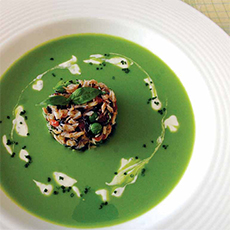




| Home | Features | Club Nights | Underwater Pics | Feedback | Non-Celebrity Diver | Events | 24 April 2024 |
| Blog | Archive | Medical FAQs | Competitions | Travel Offers | The Crew | Contact Us | MDC | LDC |

|

|
 
 |
 |
ISSUE 13 ARCHIVE - COOKING THE CATCHAndrew MaxwellPeas, Love and Crab MeatBy the time this edition of the magazine is printed, fresh peas might be out of season, but as a general rule frozen peas are actually a very good product too, so there is nothing wrong with using them.This is one of my favourite combinations of flavours, crab and peas, it is a bowl full of fresh summer flavours. For the soup:
For the crab
|
 |
SoupBring 1 litre of water to the boil, add salt and the peas. Cook until tender. In a liquidizer, blend the peas with enough cooking water to achieve the desired consistency, add the butter and blend until smooth. Pass the soup through a fine sieve and leave over ice to cool quickly.CrabBlanch the peas for 15 seconds in boiling salted water, refresh. Add the peas to the picked crab with the pepper, olives and basil. Mix the crème fraiche with the lemon and lime juice. Add the zest and chives.To servePush the crab mixture into cooking rings in the centre of each soup plate (a round pastry cutter works well for this, but if you do not have either, then a spoonful of crab, placed neatly into the middle of the bowl will also work). Pour the ice cold soup around the outside of the crab and top it with a small amount of crème fraiche.The Ultimate Guide to Buying Sustainable FishFor those of you who have followed my articles over the years, you'll know I love a rant. My soap box is a treasured possession, but I'm feeling quite calm and content with life right now, so in this edition, I'm putting together some information that I hope will be of genuine use to those of us who love to look at fish when we dive, but are also partial to the odd fish finger sandwich.I often find myself morally torn between my love of diving and my love of food – the two don't always go hand in hand, (except of course for the culinary magnificence that is the bacon and egg sandwich at Wraysbury). For those of you who share this view, here is some information that will help you buy fish, safe in the knowledge that you are not helping to ruin the very habitat that forms the foundation of your favourite pastime. |
 | |
Five simple principles to keep in mind when you're shopping
Fish to Find and Fish to Avoid from Britain's Coastline:Ten fish to avoid:
|
 | |
Ten most underrated sustainable seafish:
Don't overlook these shellfish, most of which are harvested from healthy stocks or sustainably farmed:
Some fish farming can offer a sustainable, high-welfare alternative to overfished wild stocks. It's OK to eat the following once in a while:
|
 | |
Previous article « Dos and Don'ts of Egyptian Politics Next article » Underwater Photography Back to Issue 13 Index | ||